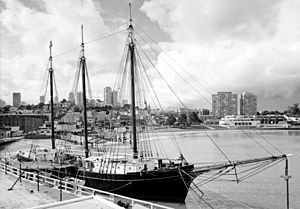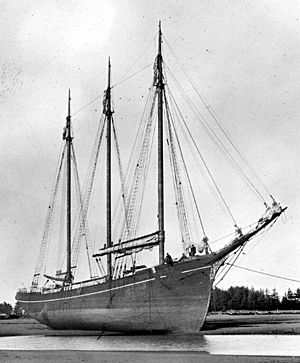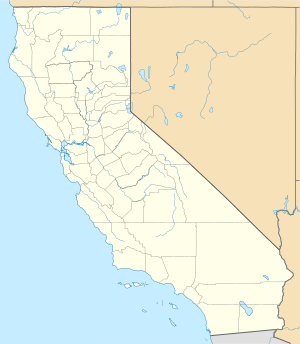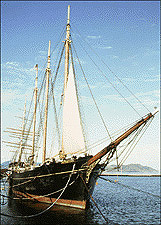C.A. Thayer (1895) facts for kids

C.A. Thayer in 1988
|
|
| History | |
|---|---|
| Namesake | Clarence A. Thayer |
| Launched | 1895 |
| Out of service | c.1950 |
| Status | Museum ship |
| General characteristics | |
| Tonnage | 453 (gross) |
| Length | 219 ft (67 m) |
| Beam | 36 ft (11 m) |
| Depth of hold | 11.38 ft (3.47 m) |
|
C.A. Thayer
|
|

C.A. Thayer, launched November 12, 1895
|
|
| Location | San Francisco, California |
| Area | less than one acre |
| Built | 1895 |
| NRHP reference No. | 66000229 |
| Significant dates | |
| Added to NRHP | 13 November 1966 |
| Designated NHL | 13 November 1966 |
C.A. Thayer is a historic schooner ship built way back in 1895. She was constructed near Eureka, California. Today, you can visit her at the San Francisco Maritime National Historical Park. This amazing ship is one of the very last sailing schooners that used to carry lumber along the West Coast. She would bring wood from Washington, Oregon, and Northern California down to San Francisco.
C.A. Thayer was named a National Historic Landmark on November 13, 1966. This means she is a very important part of American history. Many schools use this ship for fun and educational field trips.
Contents
History of the C.A. Thayer
A Ship for Lumber
The C.A. Thayer was built by Hans Ditlev Bendixsen. He was born in Denmark and had a shipyard near Humboldt Bay in Northern California. The ship was named after Clarence A. Thayer. He was a partner in a lumber company in San Francisco.
From 1895 to 1912, the C.A. Thayer mostly sailed from a mill in Grays Harbor, Washington, to San Francisco. But she also carried lumber to places as far away as Mexico. Sometimes, she even sailed to Hawaii and Fiji!
The C.A. Thayer is a typical three-masted schooner. These ships were often used for the West Coast lumber trade. She is about 219 feet long. She could carry a huge amount of wood, enough to fill about 575,000 board feet. About half of the lumber was stored below deck. The rest was stacked high, about 10 feet tall, on the deck.
When the ship was in port, her small crew of eight or nine men had to load and unload all the lumber. Unloading about 75,000 to 80,000 board feet was a normal day's work. That's a lot of wood!
Over time, more ships started using steam power instead of sails. After being badly damaged in a big storm, the C.A. Thayer stopped carrying lumber in 1912. She was then changed to work in the Alaskan salmon fishing industry.
Fishing for Salmon in Alaska
Every April, from 1912 to 1924, the C.A. Thayer sailed from San Francisco to Western Alaska. On board, she carried small 28-foot gillnet boats. She also carried barrels, tons of salt, and a crew of fishermen and cannery workers.
The ship would spend the summer anchored at a fishing camp. Places like Squaw Creek or Koggiung were common. The fishermen would use their nets to catch fish. The cannery workers would then pack the fish on shore. Each September, the C.A. Thayer would return to San Francisco. She would be full of barrels of salted salmon.
During the winter, these fishing ships usually stayed in port. But during World War I, shipping costs went up a lot. So, the C.A. Thayer started making special trips. She carried fir wood from the Northwest and redwood from Mendocino to Australia. These trips took about two months each way. On her way back, she usually carried coal. Sometimes, she brought back hardwood or copra (dried coconut meat).
Catching Cod Fish
From 1925 to 1930, the C.A. Thayer made yearly trips to Alaska's Bering Sea. This time, she was fishing for cod. She sailed from Poulsbo, Washington.
On these trips, she carried supplies and over thirty men. This included fourteen fishermen and twelve "dressers." The dressers were the men who cleaned and prepared the fish. Every day around 4:30 AM, the fishermen would launch their small dories (fishing boats). They would fish standing up, using handlines on both sides of their boats. If the fishing was good, a fisherman could catch 300-350 cod in just five hours!
After a long break during the Great Depression, the U.S. Army bought the C.A. Thayer. This was in 1942, during World War II. The Army removed her masts. They used her as a barge to carry ammunition in British Columbia.
After the war, the ship's previous owner bought her back. He put her masts back on. She returned to cod fishing. Her very last fishing trip was in 1950.
Bringing the Ship Back to Life
The State of California bought the C.A. Thayer in 1956. After some early repairs in Seattle, Washington, a group of volunteers sailed her down the coast to San Francisco.
The San Francisco Maritime Museum then did much more work to fix and refit the ship. In 1963, the C.A. Thayer was opened to the public as a museum ship. In 1978, the ship was given to the National Park Service. She was named a National Historic Landmark in 1984.
After 40 years as a museum ship, the C.A. Thayer needed more work. A big restoration project took three years, starting in 2004. During this time, she was moved from her usual spot. About 80% of the ship's old wood was replaced with new wood that matched the original. The ship sailed back to the Hyde Street Pier on April 12, 2007.
In November 2016, she was moved to Alameda for more work. She was painted, got new booms and gaffs, and had three masts and a bowsprit installed. She returned to the Hyde Street Pier in February 2017. In 2017, she was fitted with a brand new set of sails!
Images for kids







